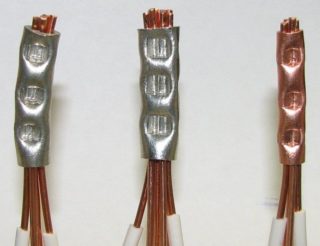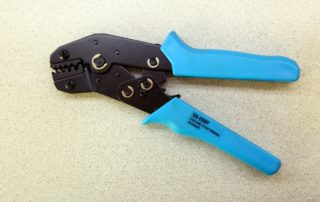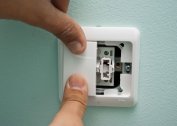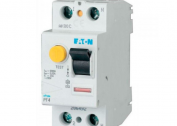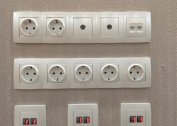To ensure an uninterrupted supply of electricity, it is important to take care of the reliable connection of wires with sleeves. A common phenomenon is twisted joints in wiring areas. From both ends, the twisting points oxidize and become very hot under heavy loads over time, which is fraught with a short circuit and spontaneous combustion. It is also important to consider that, due to the electrochemical properties of aluminum and copper, they cannot be directly connected. Special crimp sleeves for connecting wires are able to provide the most reliable crimping.
What is crimping wires with sleeves
Crimping is a common procedure in electrics, its peculiarity is the connection of electrical wiring with special sleeves. As a connecting mechanism, a connecting tube made of metal is used. For crimping wires, their cores have a sleeve. By squeezing the tube with the wires inside, it is possible to achieve a reliable connection. At home, crimping is done with pliers, but it is preferable to use a special tool - press pliers.
In two or three places, the sleeve is compressed, and the pressed place is isolated using PVC insulating tape or a heat shrink tube. Sometimes, insulated connecting sleeves are used to connect the elements, in this case there is no need to re-process the wiring section.
Connection of wires with sleeves is necessary in the following cases:
- It is necessary to connect the wires with a large cross-sectional area.
- There is no possibility of using alternative methods of connecting the wire. For example, conducting wiring inside the junction box, where at high altitude poor visibility or it is not possible to place the terminal block.
- It is necessary to connect the wires in the lines with high load.
Crimp sleeve for wires has its advantages and disadvantages. The first prevail:
- The crimping tool is equipped with a convenient working area. This principle of operation allows you to perform tasks in a confined space, for example, in junction boxes or a socket box. Inside the socket, the crimping of the wiring contacts allows you to shorten the wires to an absolute minimum.
- To compress the tube used, crimping press tongs are used. Unlike analogues, this tool does not require connection to electricity for operation, it belongs to the group of manual ones. If no electricity is connected, crimping is the only reliable way to connect wires.
- For soldering or welding, you must have certain knowledge and skills. Any person will be able to cope with crimping after the first trial time. It is important at the same time to have press tongs and consumables, in extreme cases, there must be pliers.
Crimping allows you to connect wires made of different materials, for example, aluminum and copper. Soldering and welding does not provide such opportunities.
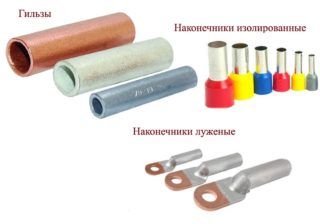 Among the disadvantages are the following:
Among the disadvantages are the following:
- The need to constantly have and regularly replenish stocks of cartridges of various sizes.
- The compound is characterized by considerable dimensions, which sometimes complicates the implementation of some tasks.
It is also worth mentioning the tangible cost of consumables.
The principle of operation of the wire crimper
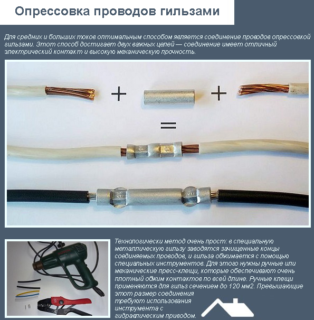 Crimping is carried out in two ways: continuous compression and local indentation.
Crimping is carried out in two ways: continuous compression and local indentation.
For crimping, aluminum or copper wire is used.Based on this, a sleeve made of aluminum or copper should be used. There is also a copper-aluminum or connecting tube for cores made of different materials.
The aluminum cable forms an oxidizing film over time, for this reason the sleeve must be carefully cleaned and processed with a special composition. To protect the material from oxidation, quartz-vaseline paste is most often used. Copper wire also needs to be treated with special compounds. Thanks to them, the probability of damage to the wire core during crimping is reduced, and the friction force is also reduced.
Stranded cores are leveled and folded so that they fit easily into the sleeve. The cable is inserted into the cartridge until it stops. The elements need to be connected not at the junction, but with a small plant.
Sleeves that are designed and designed for the total cross section of the crimped cores must be used. If a press with local (point) indentation is used, 2-3 veins are made uniformly along the entire length, this is necessary for reliable and high-quality electrical contact, as well as ensuring mechanical strength at the junction. When using square matrices or hexagonal ones, it is worth following the same rules.
It is important to ensure that the sleeve does not crack during crimping, and also to make sure that there are no pressed cavities. After crimping, the joint is isolated with a locomotive or electrical tape. The final step is to carefully fold the cable into the junction box.
Difference of crimp tubes for wires by material
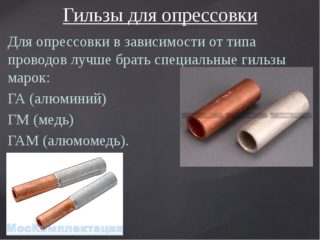 Connecting sleeves are divided into several varieties depending on the material of manufacture. The use of different types is due to the fact that, due to the electrochemical properties of metals, some react actively with each other, which leads to oxidation of the wires and their overheating under load.
Connecting sleeves are divided into several varieties depending on the material of manufacture. The use of different types is due to the fact that, due to the electrochemical properties of metals, some react actively with each other, which leads to oxidation of the wires and their overheating under load.
Copper sleeves
The abbreviation GM indicates that the sleeve is made of high-quality copper. Used exclusively for connecting copper wiring. The surface of the GM is not covered with a protective shell; therefore, it can only be operated in non-aggressive environmental conditions.
Tinned shells
With the help of tinned sleeves, copper wires are connected, designed to work in an aggressive environment. These are the same copper sleeves, only their surface is covered with a special composition that forms a protective shell of white color. The abbreviation is GML.
The advantage of tinning is to protect the material from electrochemical corrosion, however, it is forbidden to use GMF for aluminum wiring. This is due to the fact that during the compression process the protective layer is partially destroyed, which will result in direct contact of aluminum and copper.
Connecting tubes for cores from different materials
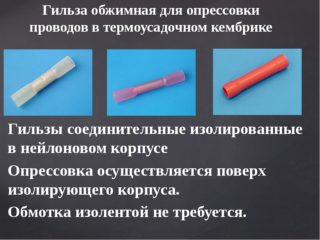 Carrying out electric lines, as a rule, is not complete without the use and connection of cores made of different materials. For such purposes, special sleeves are used, which are considered combined and are called GAM. The design is simple, but its feature is the use of different materials. Two parts of the tube are welded into one, one made of aluminum and the other made of copper. The middle, the junction is equipped with a special limiter. Thanks to it, an equal entry of veins is provided on both sides.
Carrying out electric lines, as a rule, is not complete without the use and connection of cores made of different materials. For such purposes, special sleeves are used, which are considered combined and are called GAM. The design is simple, but its feature is the use of different materials. Two parts of the tube are welded into one, one made of aluminum and the other made of copper. The middle, the junction is equipped with a special limiter. Thanks to it, an equal entry of veins is provided on both sides.
This variety differs in form. This can be explained by the fact that the aluminum part of the tube has a larger diameter due to the need for a larger cross section at the conductor.
The GAM crimping algorithm is similar to the previous methods.
There is another kind of sleeves designed for crimping wires. Its difference lies in covering the surface with insulation. Their operation does not require additional use of heat shrink tubing or PVC tape.The surface of the liners is coated with a material that is characterized by plastic characteristics. During crimping, the PVC layer is also compressed, but there will be no direct contact between the sleeve and the wire.
Crimping Tools
In any hardware store, the electrical goods department has a large assortment of cartridges. Also, to perform the task, a crimping device is purchased. The most budgetary and sought after:
- Two-lip equipment has the appearance of pliers, but is additionally equipped with compression reinforcement with two jaws. There are also different types of sponges for crimping, for example, round tips or forks. The average cost in the Russian market is 800 - 1000 rubles.
- An analog of the previous device is four-lip crimpers. They are exclusively for thermowells. The cost is several times higher and already starts from 2000 rubles.
- Wire stripping device. There are several types and modifications depending on the material of which the wiring is made.
A cutter may also come in handy for precise cuts. The price is more than acceptable, about 150 rubles.
Press pliers
The most common crimping tool for thermowells is press pliers. They are used even for domestic purposes, since they can be used to crimp various terminals and non-standard connectors.
There are several varieties of press ticks, depending on the purpose:
- for crimping sleeves;
- to remove the insulating layer from the core.
The crimp design is divided into several varieties, their main difference lies in the size and shape of the nests. The nest may be trapezoidal or square. Also, the sockets are divided by additional equipment or the absence of plastic flanges. With their help, a reliable crimping of a multicore cable is carried out.
To obtain a reliable connection, it is necessary that the size of the tool corresponds to the diameter.
Modifications of crimping press pliers:
- A tool designed for non-insulated parts. It is equipped with one rod, which is in the process of crimping at the dividing joint. The crimping of the pipe itself should be carried out in the center.
- Equipment designed for insulated parts. Equipped with three oval shaped matrix presses. Each of them is inherent in blue, red and yellow. Insulated tubes are painted in similar colors to make it more convenient to select the necessary press.
Sleeves for crimping wires is a kind of one-piece connection. In order to avoid installation errors, you need to have a wiring diagram before your eyes.
